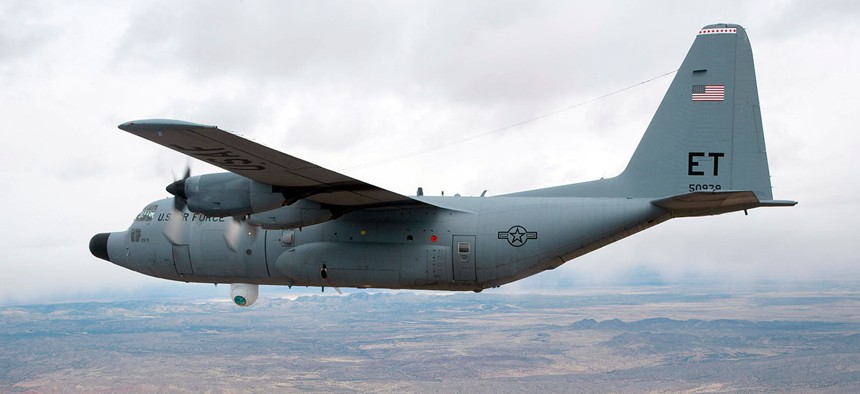
A specially modified 46th Test Wing NC-130H aircraft equipped with the Advanced Tactical Laser weapon system. Air Force
Air Force Wants to Test a Laser on an Attack Plane Within A Year
But the U.S. Special Operations Command still needs money for the test and policymakers need to figure out the rules of engagement.
ORLANDO, Fla. — U.S. Air Force leaders hope to test a new weapon aboard one of their most beloved attack planes within the next year: a laser.
A laser-armed C-130 project is U.S. Special Operations Command’s top unfunded priority, according to Lt. Gen. Brad Webb, the head of Air Force Special Operations Command.
“I’m pretty optimistic,” Webb said of the project Thursday at an Air Force Association-sponsored conference. “There are a lot of vendors that are really contributing to and continue to push that technology along.”
The plan is to install a relatively low-kilowatt laser, do a “proof of concept and go from there,” Webb said, increasing power laser weapon after it’s proven accurate and effective in testing. The command has money “to do the first steps” of the project.
Perhaps best known for its 105-millimeter howitzer, the AC-130 has received a host of upgrades and improvements in recent years. Newer gunships pack even more firepower, carrying missiles and bombs. Lasers have been attractive to the military as a cost-effective alternative to traditional guns and missile. But making the weapons small, accurate and powerful enough has been difficult.
As testing advances and the laser weapon gets closer to the battlefield, the rules of engagement must be determined, Webb said.
“At some point … a policy discussion is going to have to be had on where and how can you use a laser and where and where and how can you not,” he said. “But I think that’s a discussion to be had further down the road.”
The Pentagon has experimenting with laser weapons for decades. In 2009, the Advanced Tactical Laser — fired from a C-130 — burned a hole in the hood of a truck. In 2014, the Navy deployed a laser on an amphibious transport dock in the Persian Gulf. The captain of the ship was given permission to use the laser as a defensive weapon.
“I still contend that an offensive capability — which is what we’re looking for in the AFSOC contribution to the effort — is contributing to the defensive aspects that other commands are looking [for],” Webb said.
The Air Force and the Pentagon’s Missile Defense Agency spent billions of dollars putting a laser on the nose of the 747 jetliner that would be used to shoot down ballistic missiles. The project was canceled in 2012. Webb acknowledged that the project, which didn’t field an operational aircraft, left a bad taste in people’s mouths.
“There are massive supporters within our government and elsewhere on seeing that this technology has a future,” he said. “There are those that look at the experience of what I think you would have to acknowledge was not a slam dunk success, with respect to the Airborne Laser.”
But, Webb said, the laser being eyed for AFSOC AC-130s “is technology that is very different than that.”
“We need to have this proof of concept,” he said. “Let’s get a layup out of the chute and then we can take this step-by-step.”







